December 5, 2025 | 17:35 GMT +7
December 5, 2025 | 17:35 GMT +7
Hotline: 0913.378.918
December 5, 2025 | 17:35 GMT +7
Hotline: 0913.378.918
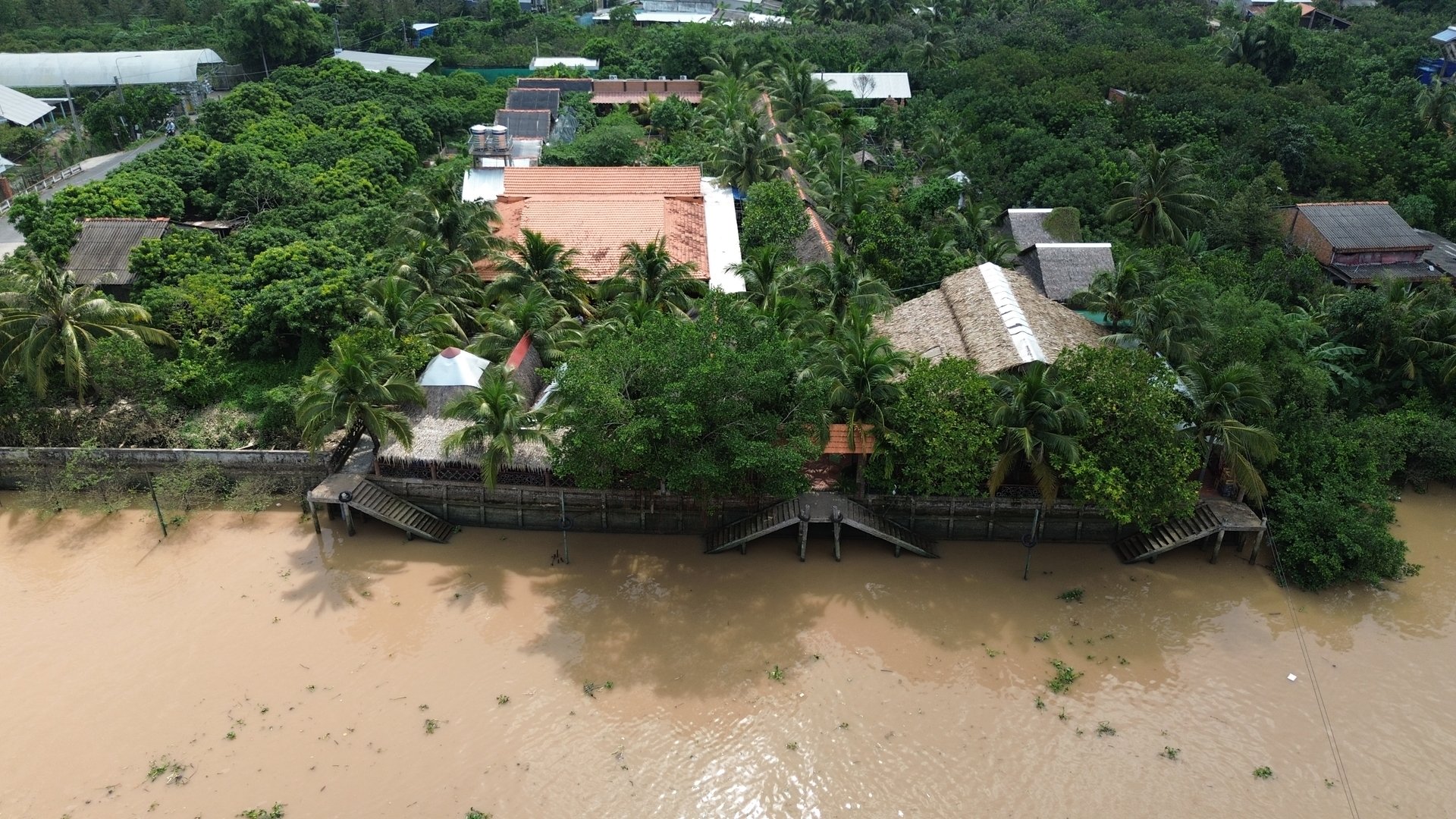
Aerial view of the coconut house standing out amid the waterways of Cu Lao An Binh. Photo: Ho Thao.
In Cu Lao An Binh, Vinh Long province, there is a unique three-compartment house that amazes every visitor. Not only is it a typical example of Southern Vietnamese architecture, but it is also built from 1,700 old coconut trees, over 80 years old, known for their dense, durable wood that naturally resists termites.
The owner of this one-of-a-kind house is Mrs. Vo Ngoc Giac (An Binh commune), who, together with her daughter Duong Dieu Hien, spent two years designing and building it. Today, the “coconut house” is not only a residence but also a tourist attraction recognized as a 4-star provincial OCOP product under the name COCO HOUSE.
Starting as a tour guide, Ms. Hien met many international tourists. Over the years, she realized that experiential tourism in Vinh Long lacked a distinctive highlight, especially in architecture.
“Most attractions revolve around fruit gardens and local specialties, but have few structures that can keep visitors longer than an hour. I wanted to do something different — to preserve traditional values, promote environmental protection, and help elevate the local tree species,” Ms. Hien shared.
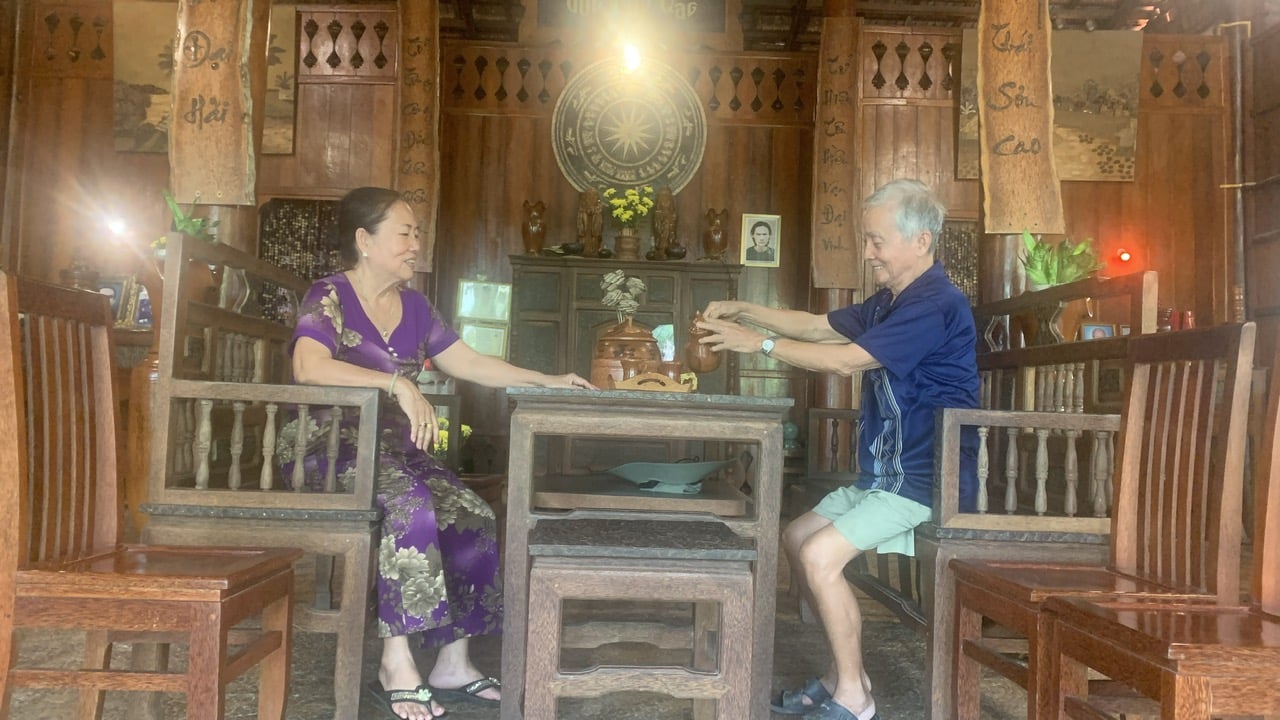
Mrs. Giac and her husband enjoy tea on a long bench set crafted entirely from coconut wood. Photo: Ho Thao.
From there, Ms. Hien came up with the idea to build a traditional three-compartment house made entirely of coconut wood — a tree known as the "tree of the Vietnamese people," yet rarely fully utilized in architecture. Every part of the coconut tree was carefully used, from the roots, trunk, base, shell, fiber, to even the leaves and bark.
“Coconuts seem to be just for water and flesh. But through a creative eye, every fiber strand and shell can be transformed into art,” Ms. Hien said.
To complete the project, Ms. Hien traveled to various districts in Ben Tre province, the "coconut capital," to find old coconut trees. Only trees aged 80 to 100 years had the proper hardness, straightness, and durability. After months of collecting, they selected nearly 4,000 trees meeting the standards.
“Coconut trees grow leaning with the wind and easily curve, so finding straight ones suitable for house columns or woodwork was extremely difficult. Sometimes only 1 out of 10 trees was chosen. Then we had to hire craftsmen for cutting, turning, and carving - all done by hand, which was very painstaking and cost three times more labor than traditional house construction,” Mrs. Giac recalled.
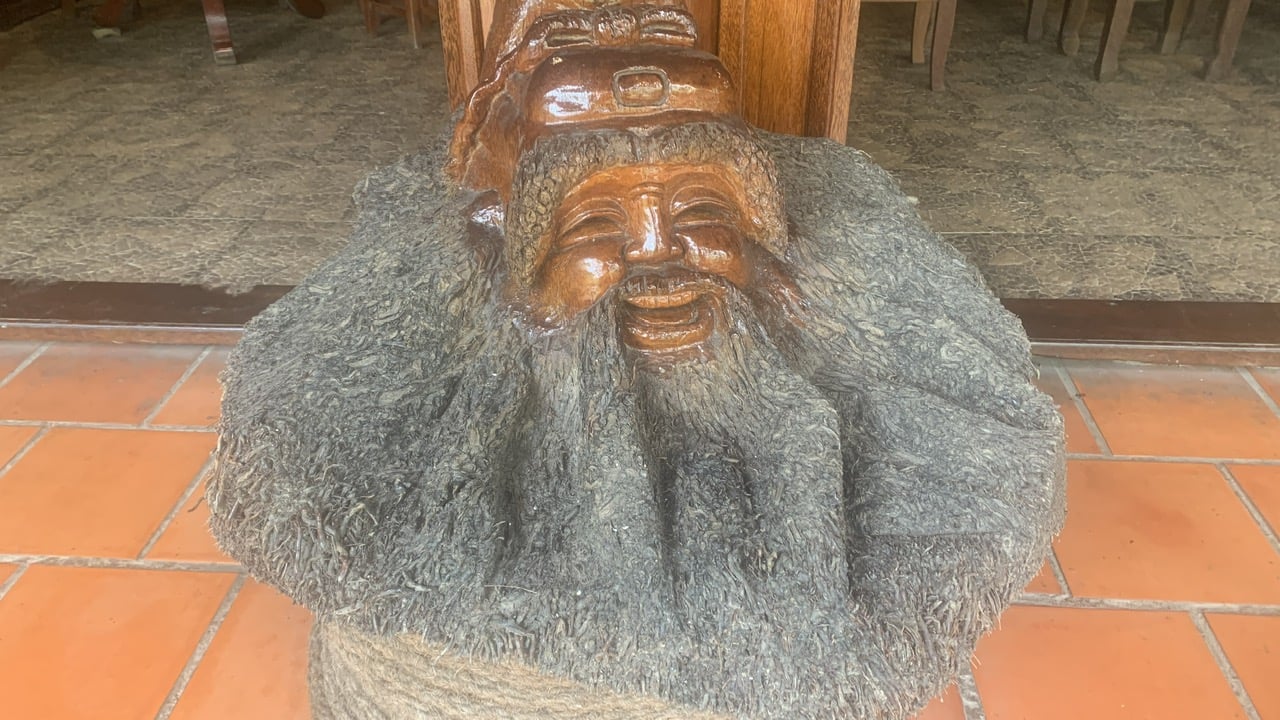
A finely crafted statue of Ong Tho, carved by an artisan from the root of an old coconut tree. Photo: Ho Thao.
Every detail in the house amazes visitors. Coconut roots are carved into statues of the 12 zodiac animals, along with statues of Phuc, Loc, and Tho placed in the front yard. Coconut trunks are used for pillars, beams, tables, chairs, altars, and beds. Coconut shells are cut, pressed, and polished to make floor tiles, wall art, couplets, incense burners, and lamp stands. Coconut leaves are crafted into hanging hats and decorative lamps, while coconut fibers serve as lightweight decorative materials.
Visitor Ho Ngoc Diep from Hung Yen shared, “At first, I only saw a beautiful old house. But when the owner explained each detail, I was truly amazed. I never thought coconut shells could make an entire floor and be carved into such beautiful calligraphy. Each item reflects incredible craftsmanship and heartfelt dedication.”
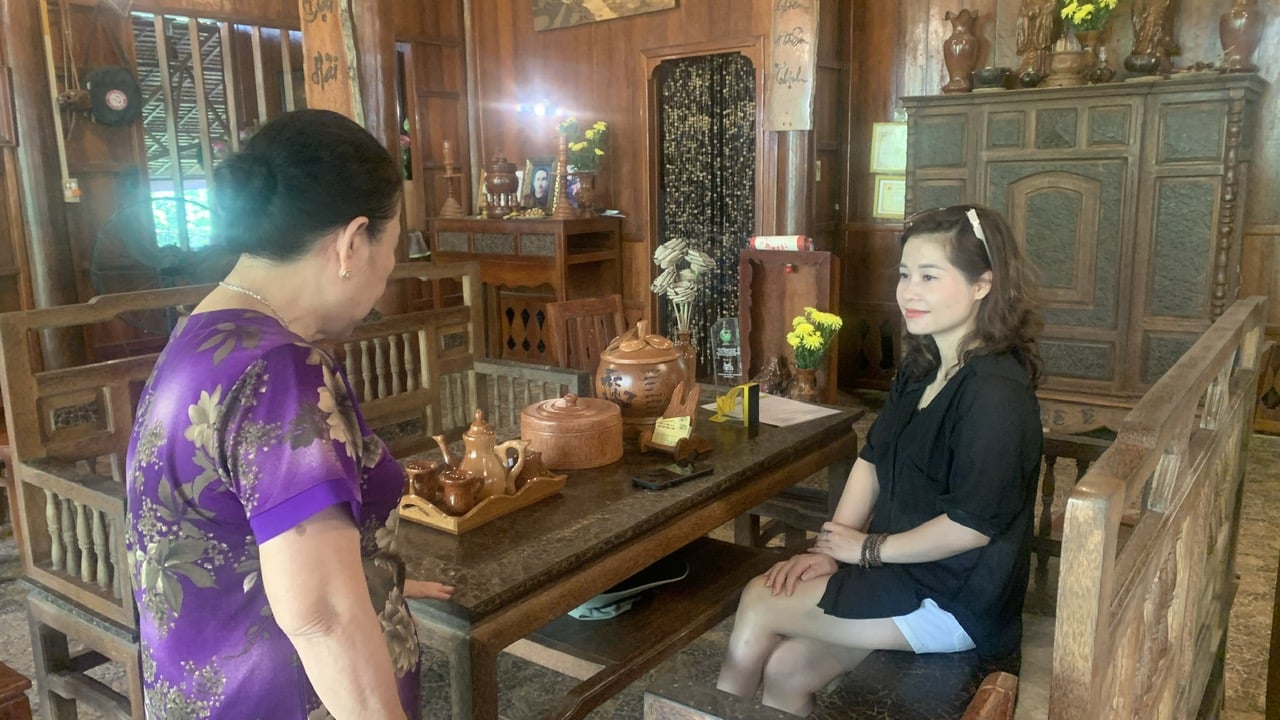
Visitors listen attentively as Mrs. Giac shares the unique story behind the coconut house. Photo: Ho Thao.
Each year, the coconut house welcomes thousands of visitors, including many international tourists from Japan, France, the Netherlands, the United States, and more. They come not only to admire but also to learn how Vietnamese people recycle natural materials in their living spaces. Many domestic groups also choose this place for tours, to study green architecture models, and to preserve local heritage.
Recognizing the potential for eco-tourism combined with educational experiences, Mrs. Giac’s family expanded the grounds and built a dining area where all the utensils: tables, chairs, cups, spoons are made from coconut. The space is rustic and welcoming yet full of creativity, inspiring fresh ideas for green living.
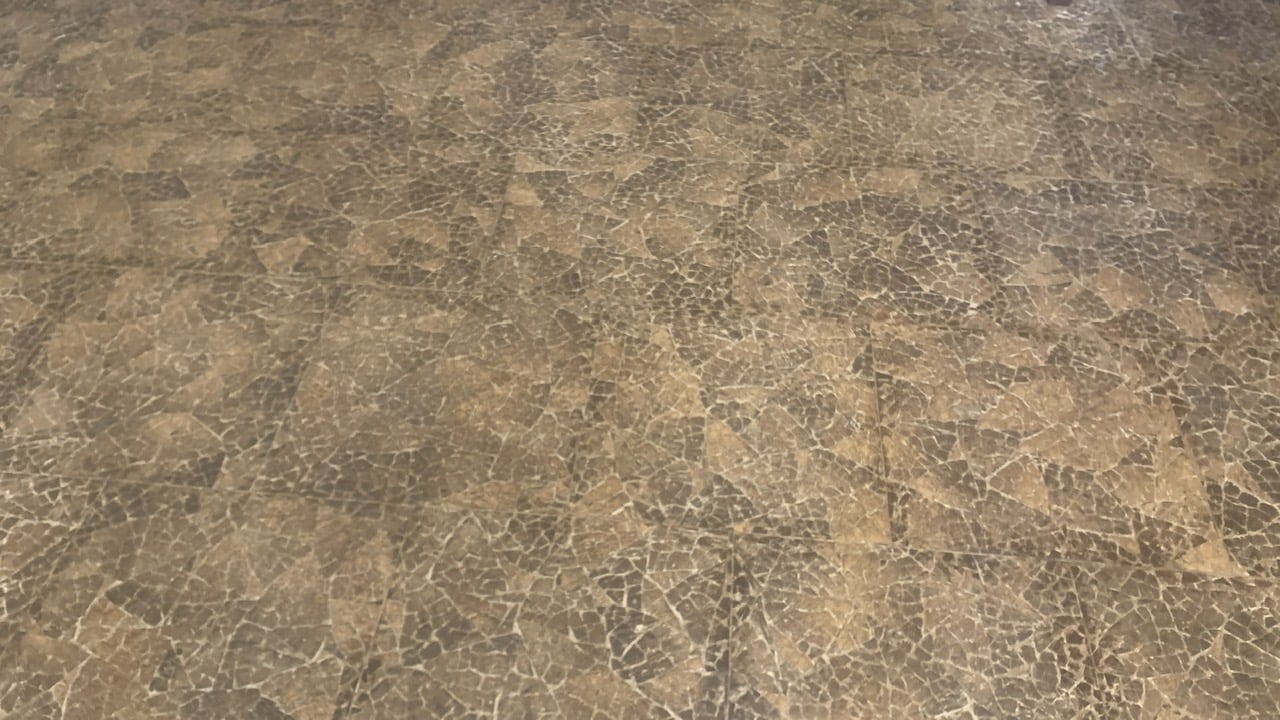
The unique floor is paved with coconut shells, both eco-friendly and reflecting the rustic charm of the Mekong Delta. Photo: Ho Thao.
Mrs. Giac added, “In the future, if the budget allows, I plan to replace the entire roof with coconut shells and pave the walkways with coconut tiles, making the house truly 100% coconut. This is not only my family’s pride but also a living legacy I want to leave for future generations about the Vietnamese coconut tree.”
According to the homeowner, in the context of climate change, when eco-friendly materials are becoming an inevitable trend, the “coconut house” holds great inspirational value. It not only helps preserve the cultural heritage of traditional Western houses but also sparks creativity and responsibility towards the environment. Most importantly, it carries a proud message: The Vietnamese coconut tree is not just the shade of our homeland but also a symbol of wisdom and identity.
Translated by Phuong Linh

(VAN) As of 2025, the ASEAN region has a total of 69 ASEAN Heritage Parks recognized across its 10 member states. Among them, Viet Nam contributes 15 ASEAN Heritage Parks.

(VAN) Yok Don National Park has high biodiversity with numerous endemic plant and animal species, and it is also the only dipterocarp forest ecosystem conservation area in Viet Nam.

(VAN) Viet Nam and Brunei signed two important MOUs on fisheries and IUU, expanding cooperation in agriculture, the environment, and Halal exports, aiming to substantively implement joint projects.

(VAN) The Viet Nam Coconut Association worked with the International Finance Corporation (IFC) and businesses to promote the supply chain, enhance competitiveness, and develop the coconut industry sustainably.
![Hue aims for Net Zero: [2] Pioneering low-emission tourism](https://t.ex-cdn.com/nongnghiepmoitruong.vn/608w/files/huytd/2025/12/04/0633-dulichzero-4-095634_236-161125.jpg)
(VAN) The ancient capital of Hue has developed Net Zero tourism products and models, aiming to reduce carbon emissions and pioneer the establishment of Viet Nam's green tourism destination.

(VAN) C.P. Viet Nam has announced the successful completion of its goal to plant 1.5 million trees during the 2021-2025 period, a key milestone within company's long-term ESG strategy and its roadmap for emission reduction.

(VAN) This is an initiative of MAE aimed at creating a unified coordination mechanism to implement agricultural cooperation programs with developing countries.